
Underworld Races of Aventyr

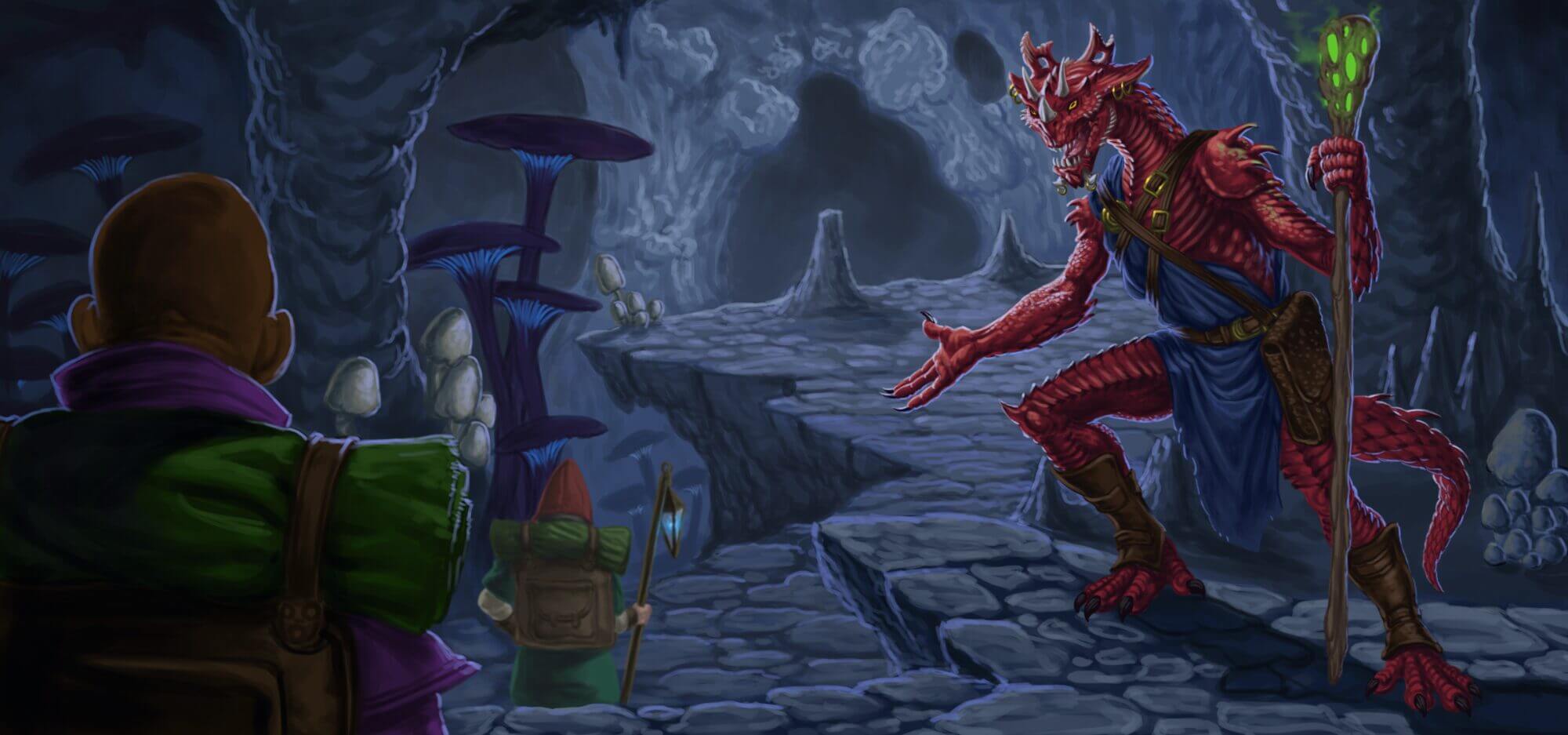
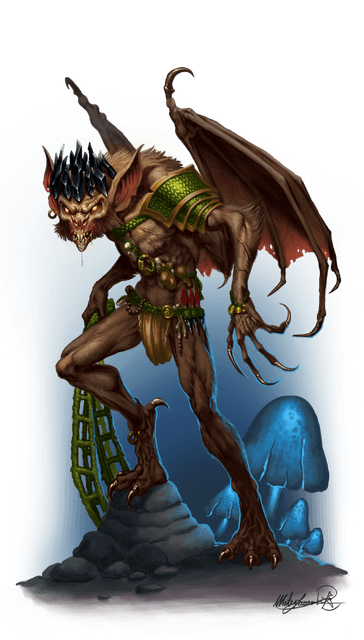
Ahooling
Wild. Primal. Unchained.
The ahooling are the winged children of the Underworld’s primal terror—the monstrous, bat-like ahool. Though smaller and more intelligent than their savage forebears, ahooling are no less fierce. With leathery wings, sharp senses, and razor claws, they embody the chaotic heartbeat of the deepest wilds. To encounter an ahooling is to meet a predator who has chosen self-awareness over savagery—but whose instincts are never far from the surface.
Echoes of the Beast
Ahooling society is rare and often fleeting. Born into roosts carved into the stone ceilings of immense Underworld caverns, these winged humanoids undergo harsh trials to survive their formative years. The strongest remain within their primal flocks, serving the great ahool as hunters, scouts, and defenders. Others—exiled, curious, or disillusioned—seek their own paths, often fleeing the oppressive hierarchy of fang and wing.
Their resemblance to nightmares of the Upperworld makes life difficult in more civilized spaces. Ahooling adventurers must fight to be seen as more than monsters, often choosing isolation, mercenary work, or wilderness paths where their sharp eyes and keen senses serve them best.
“I flew farther than the scream of my sire. What I found was not peace—but choice.” — Kurrak Skybreak, ahooling ranger
Traits and Tendencies
- Natural Hunters: Most ahooling excel as rangers, rogues, or barbarians, leaning into their physical prowess and nocturnal senses.
- Lone Flyers: Distrusted by others and instinctively territorial, many ahooling become wanderers or survivalists.
- Echo-Memory: Some possess uncanny memory linked to sound—remembering songs, threats, or voices with perfect clarity.
Ahooling Adventurers
- A former flock-leader now on the run from a cruel ahool matriarch
- A bard who sings stories in echolocation to rattle the bones of the dead
- A monk who tames their instincts through rigorous Underworld philosophy
- A vengeance-seeker haunted by memories of their ahool kin’s brutality
One of the most infamous ahooling to walk the Upperworld was Mel’Chizedek, a deeply misunderstood figure. Though his intentions were noble, his instincts often got the better of him—most notably when he drank the blood of a noble’s beloved pet, mistaking it for an offering. In another mishap, he fed on a recently deceased ally during a wake, believing it to be customary. Though Mel’Chizedek eventually became a hero to a remote village he saved from a plague of undead, his early years were marked by scandal and fear. His tale serves as a cautionary but sympathetic reminder that the ahooling must navigate a world built for beings unlike themselves.
Cultural Conflicts
Ahooling walk a difficult line between civilization and beast. Many are treated as dangerous oddities by surface dwellers and as weaklings by their ancestral kin. Despite this, some have found purpose among dwarves of the Forever Deep, or even in the service of Colliatur crusades against undead infestations. In the absence of a homeland, many ahooling find meaning in travel—and in revenge.
Related Lore & Resources
- Underworld Races & Classes – Ahooling Race Profile
- Occult Secrets of the Underworld – Cultural Flavor & Origins
- Aventyr Deities – Vasi – Some ahooling revere the water goddess for her fluidity and strength
- Rise of the Drow: After the Fall – Setting Tie-In

Colliatur
Radiant. Unyielding. Eternal.
The Colliatur are beings of light forged in defiance of death. Born of an ancient pathogen unleashed in the Underworld’s blackest streams, these radiant beings embody resistance against darkness—especially against undeath. With gleaming crystal-like skin and a holy fervor pulsing through their veins, the Colliatur are both saviors and zealots.
Luminescent Origins
Millennia ago, a forbidden magical experiment by the undead sorcerer Udødelig unleashed a biological curse known as the colloid, intended to enslave the living to his necrotic will. But something went wrong. Instead of submission, a rare mutation occurred—and from this resistance, the Colliatur were born.
They emerged from the abyss radiant and whole, vessels of an inner light. Many now crusade across Aventyr, especially in the Underworld, seeking to purify it of undead corruption. To see a Colliatur stride into battle is to behold a being cloaked in halos and purpose.
“By my light you are revealed. By my stride, your end arrives.” — Khyros the Gleaming, Colliatur Justicar
Culture of Illumination
The Colliatur have no true homeland. Instead, they wander as missionaries, guardians, and executioners of undeath. Temples dedicated to light and justice may host small enclaves of these radiant beings, who often take up roles as clerics, paladins, or radiant sorcerers.
Though revered in many communities, their judgment is often absolute. Colliatur offer no quarter to those who consort with the undead, and they rarely forgive those who obstruct their cause.
Colliatur Adventurers
- A radiant war-priest seeking the lost tomb of Udødelig
- A stoic paladin who believes the surface world must be saved before the Underworld
- A wandering exorcist who hears the cries of the dead with every footstep
- A light-infused wizard who fears the glow within is slowly consuming their soul
Traits and Tendencies
- Undead Bane: Most Colliatur dedicate themselves to hunting the undead, either through divine power or martial might.
- Shining Presence: Their luminous appearance inspires awe and sometimes fear.
- Ascetic Wanderers: Most live minimalistic lives, focused on their sacred missions.
Cultural Conflicts
The Colliatur are celebrated by many surface dwellers, but some fear their zealous commitment. In the Underworld, their presence is both blessing and blight—to allies of the undead, they are heralds of destruction; to the oppressed, symbols of deliverance. They often clash with necromancers, gitwerc soul-traders, and ancient vampire cults.
Related Lore & Resources
- Underworld Races & Classes – Colliatur Race Profile
- Occult Secrets of the Underworld – Origins of the Colloid Pathogen
- Aventyr Deities – The Breath of Life – Some Colliatur worship this embodiment of ancestral harmony and natural purity
- Rise of the Drow: After the Fall – Setting Tie-In
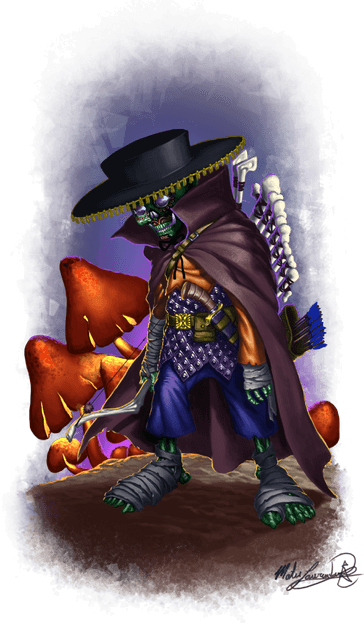
Dødelig
Immortal. Macabre. Whimsical.
Dødelig are small, skeletal beings that dance on the edge of life and death—undead, yet free from necromantic chains. Cackling scholars, curious wanderers, and cheerful bone collectors, they roam the Underworld in search of stories, knowledge, and lost kin.
Undeath Without Misery
Unlike most undead, the dødelig are not bound by evil, necromancy, or despair. These immortal curiosities emerged from forgotten cataclysms deep within the Underworld—particularly within the corpse of the Dracoprime, a titanic dragon god whose remains form a subterranean mountain of bone and magic. Here, the dødelig first awakened, born of spiritual fracture and raw magical fallout.
They are not ghosts nor revenants, but true skeletal beings—whole in body, if not always in mind.
“Life is so short, unless you’re dead! Then there’s all the time in the world.” — Winklebone the Laughing Archivist
Curious and Carefree
Dødelig are mischievous and often misunderstood. They see the world as a place of endless intrigue, capable of delight, horror, and surprise—three things they love most. They form eccentric communities in bone-covered hollows and abandoned ruins, often decorating their homes with relics, scribbled lore, and masks carved from skulls.
While most dødelig harbor no ill will, their appearance often sparks fear or disgust among the living. Many take this in stride, reveling in pranks or storytelling to earn wary friendship.
Dødelig Adventurers
- A bone-bard who sings only songs he’s heard from dying mouths
- A rogue who infiltrates crypts not to loot, but to throw parties for the dead
- A wizard seeking the soul-spark that might explain why the dødelig still think and feel
- An archivist on a quest to collect the stories of every person who has ever lived
Traits and Tendencies
- Playful Immortality: They cannot die from age and often treat mortal life with a mix of fascination and detachment.
- Undeath Perspective: Dødelig don’t fear death—but they’re very curious about what lies beyond it.
- Eccentric Collectors: They hoard stories, artifacts, and peculiar experiences like treasures.
Cultural Quirks
The dødelig don’t understand why anyone would fear bones—they find skeletons comforting. They often give each other new skulls as gifts or decorate their ribs with tattoos inked in shadow sap. Many speak in riddles or ancient songs, not out of mystery but habit.
They despise necromantic domination and the colloid pathogen in particular, which seeks to enslave their kind. Dødelig see Colliatur as tragic heroes, and sometimes even prank them to try and loosen their rigid glow.
Related Lore & Resources
- Underworld Races & Classes – Dødelig Race Profile
- Occult Secrets of the Underworld – Notes on the Dracoprime’s Remains
- Rise of the Drow: After the Fall – Underworld Culture Tie-In

Draaki
Forgotten. Draconic. Doomed.
Once regal masters of the Underworld, the Draaki were a proud race of enchanted beings who shaped empires and tamed dragons. Now they are shattered remnants of their former glory—nomads, survivors, and outcasts haunted by the memory of their own cataclysm.
The Fall of Greatness
Long ago, the Draaki were stewards of powerful arcane knowledge and had even subjugated the dragons of Aventyr. Their society rivaled the elves in sophistication and strength. But hubris opened the door to ruin. A series of reckless magical experiments and pacts with ancient wyrms resulted in a chain reaction of arcane disasters. The Draaki empires crumbled, and their population was scattered across the endless caverns.
Today, the Draaki are feared and pitied—feared for the echoes of their draconic blood, pitied for the irreversible loss of their civilization.
“We were once kings of fire and stone. Now we are ash carried on the breath of ancient sins.” — Serixh the Ash-Walker
The Ashbound Culture
No Draaki enclave remains unbroken. Tribes form and dissolve in the dark. Some wander aimlessly. Others hoard ruins, obsessively trying to restore what was lost. Most Draaki still carry an ember of their heritage: a deep affinity for dragons, and a latent power that stirs when blood is spilled.
The strongest among them may grow scales, claws, or even wings. Some are mistaken for dragonborn—but the Draaki are something far older, and far more cursed.
Draaki Adventurers
- A scholar tracing lost Draaki cities to reclaim ancestral magic
- A mercenary whose draconic rage manifests when allies fall
- A dragon-summoner seeking vengeance against the beast who betrayed her bloodline
- A penitent exile carrying a fragment of the spell that destroyed their people
Traits and Tendencies
- Draconic Legacy: Draaki often exhibit subtle physical traits reminiscent of dragons—horns, scaled patches of skin, glowing eyes.
- Arcane Bloodline: Magic runs strong in their veins, particularly sorcery tied to dragons, fire, or ruins.
- Haunted Memory: Draaki often speak in poetic fragments or riddles, echoing their shattered cultural psyche.
Cultural Themes
The Draaki walk between reverence and regret. Some believe they are cursed by the dragons they once controlled. Others see themselves as the last hope to rebuild what was lost. Many Draaki distrust outsiders, especially elves and humans, whose own empires remind them of their past sins.
They sometimes bond with others cast out from society—tieflings, drow, or even drow-born driders—forming tight-knit fellowships in the unforgiving Underworld.
Related Lore & Resources
- Underworld Races & Classes – Draaki Race Profile
- Occult Secrets of the Underworld – Magical Collapse and Draconic Binding
- Rise of the Drow: After the Fall – Underworld Societal Ruins
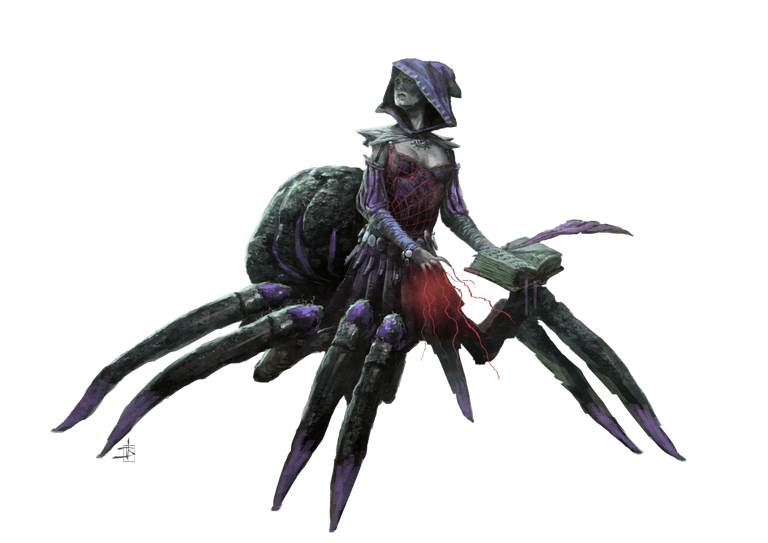
Drider
Cursed. Twisted. Resilient.
The Drider are a living embodiment of divine punishment—once drow, now fused with monstrous spider forms. They are feared and reviled in equal measure, but beneath their terrifying appearance lies a complex tale of faith, defiance, and survival in the deepest shadows of the Underworld.
Spawn of Punishment
When a drow fails their Spider Matron—whether through failure, heresy, or disobedience—they risk the ultimate curse: transformation into a drider. The process fuses their upper body with the lower half of a giant spider, warping both body and soul. In many drow cities, driders are driven out or forced into the most dangerous duties, their existence a shameful reminder of imperfection.
Yet in recent years, some driders have begun to forge their own identity. Exiled and persecuted, they gather in hidden caverns or broken ruins, building new societies outside the dominion of the Spider Matron. There, they seek redemption, purpose—or vengeance.
“The Matron cursed me with eight legs and fangs. I thanked her, then used them to climb higher than any priestess ever dared.” — Vrez’Thur of the Webless Deep
Weavers of Fate
Though ostracized from most drow cities, driders retain their intellect, cunning, and magical prowess. Their unique biology allows them to traverse vertical terrain, spin silk strong as steel, and create traps unlike any other Underworld race. Some driders embrace their monstrous form, becoming hunters and assassins. Others turn inward, weaving intricate philosophies from their suffering.
A drider community is a paradox—part temple, part lair, part rebellion.
Drider Adventurers
- A fallen drow priestess seeking to slay the goddess who cursed her
- A philosopher-spider who preaches a new path beyond the Matron’s tyranny
- A rogue assassin who uses silk webs as traps and tightrope battlefields
- A warlock whose patron is not a demon, but the memory of her own punishment
Traits and Tendencies
- Silken Cunning: Driders use their webs for utility, shelter, and ambush.
- Wall-Walkers: Their spider legs allow them to traverse places others can’t reach.
- Exiled Minds: Many grapple with their drow past—some embrace it, others reject it entirely.
Campaign Themes
Driders often fill the roles of tragic antiheroes, hunted outcasts, or bitter rebels. They may forge strange alliances with other Underworld pariahs like funglets, vestraadi, or half-drow. Some have begun to reclaim ruined drow cities as their own, forming cult-like followings of other cursed beings.
They are especially prominent in the Rise of the Drow: After the Fall campaign setting, where driders become playable characters navigating the fractured ruins of Holoth.
Related Lore & Resources
- Drider of the Underworld – Race Profile & Cultural Development
- Underworld Races & Classes – Drider Ancestry and Mechanics
- Rise of the Drow: After the Fall – Drider Character Options
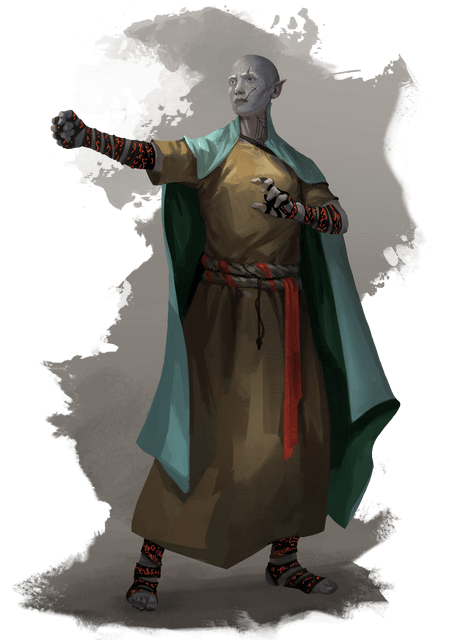
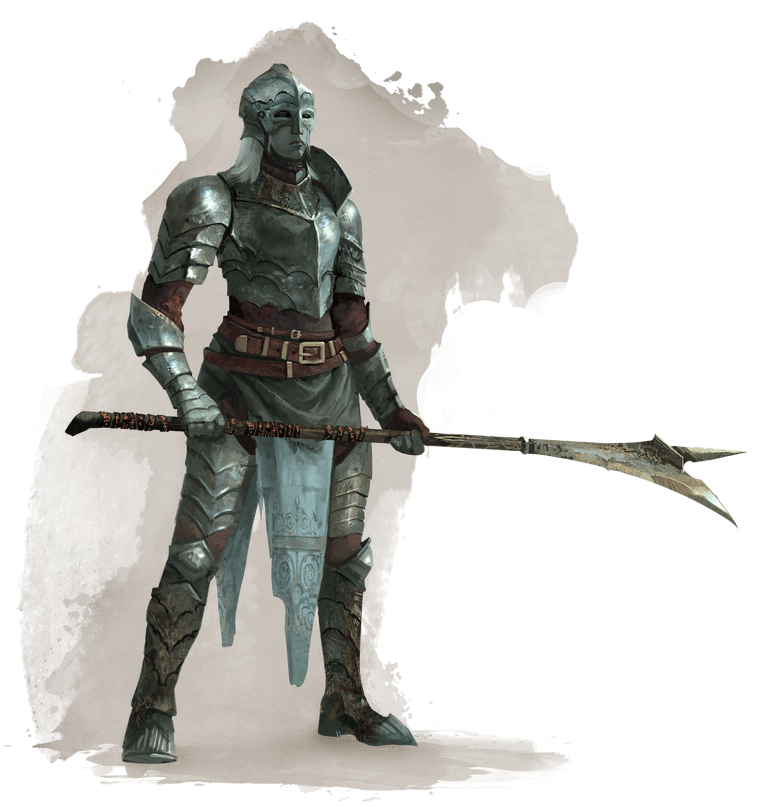
Drow
Cunning. Ruthless. Enigmatic.
The drow of Aventyr are a people shaped by darkness—both the literal depths of the Underworld and the metaphorical shadows of betrayal, divine wrath, and ambition. They once shared the surface with their elven kin, but thousands of years of exile and devotion to the Spider Goddess Naraneus have transformed them into a powerful, secretive race that thrives in the subterranean world.
Origins in Shadow
The drow were cast from the Upperworld long ago during a schism among the elven peoples. Those who followed Naraneus, the Spider Goddess, descended into the Underworld, where they built grand cities and forged their own culture—one of beauty, brutality, and matriarchal rule.
Over time, the lack of sunlight caused their skin to gradually lose pigmentation, resulting in shades of dusky purple, gray, and ashen violet. Prolonged subterranean life and exposure to arcane forces further deepened these hues, while their eyes took on glowing colors of red, amber, pale violet, and icy blue, often shimmering with divine or magical resonance.
Matriarchal Might
Drow society is ruled by powerful noble houses, each led by a Matron Mother who serves Naraneus. These women command armies, conduct rituals, and manipulate alliances with lethal precision. Males typically serve as warriors, mages, or scouts—respected for their skills, but rarely trusted with power.
The faith of the drow is absolute. Temples to Naraneus dominate every major city, and priestesses hold enormous sway. Her will is interpreted through visions, omens, and blood sacrifices.
“We are children of the web. Every thread you pull is one we have already spun.” — Matron Shalryssa Vonn’Zorlin, House Vonn’Zorlin of Holoth
Culture of Webs
Drow cities like Holoth—once mighty, now shattered—are elegant yet lethal, rising from massive caverns in spires of sculpted stone and magical light. Their architecture spirals, climbs, and entwines like a spider’s web, designed both to awe and to entrap.
Though they practice slavery and subjugation, drow culture is not without beauty. They produce haunting music, exquisite craftsmanship, and breathtaking art—often depicting Naraneus’ divine acts or scenes of conquest.
Drow Adventurers
- A priestess sent to reclaim an artifact lost in the collapse of Holoth
- A rogue noble seeking vengeance against a rival house
- A drider exile hunting for redemption
- A defector who has sworn off the Spider Goddess and now seeks a new path
The Fall and Aftermath
The fall of Holoth, detailed in Rise of the Drow: After the Fall, was a turning point in drow history. Once a symbol of their dominance, the city now lies in ruin, occupied by a coalition of dwarves, funglets, and other Underworld forces. The surviving drow must decide whether to rebuild, rebel, or rule anew.
Some have turned to dark alliances. Others seek to rekindle ancient traditions. Many wander as fugitives or spies, trying to restore their people’s place in the Underworld.
Traits and Tendencies
- Deceptive Strategists: Intrigue is a daily game in drow society.
- Magical Prodigies: Many drow possess innate spellcasting abilities, especially related to shadow, poison, and illusion.
- Social Hierarchies: Drow respect power, cunning, and devotion to Naraneus above all.
Driders and Outcasts
Driders—drow cursed or elevated by the Spider Goddess—are half-drow, half-spider abominations. Some serve as shock troops and temple guardians. Others roam the wilds, exiled or driven mad. Their presence is explored in depth in Drider of the Underworld.
Related Lore & Resources
- Rise of the Drow: After the Fall – Kickstarter Campaign
- Underworld Races & Classes – Drow Lore & Mechanics
- Drider of the Underworld – Drider Origins & Adventure Hooks
- Occult Secrets of the Underworld – Drow Sorcery & Spider Goddess Worship
- Aventyr Deities – Naraneus
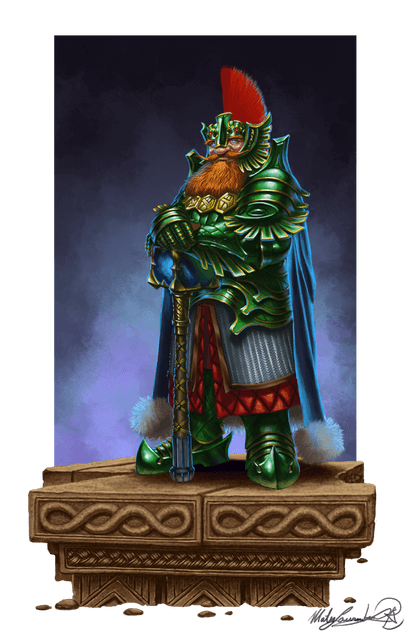
Dweorg, Dwarf
Industrious. Honorable. Enduring.
Dweorg are the stoic surface-dwelling dwarves of the Underworld’s fringe—blacksmiths, builders, and guardians of ancestral legacy. Born of stone and fire, these dwarves uphold ancient codes passed down from the first forgemasters. Unlike their deeper-dwelling cousins, dweorg have acclimated to the surface world, enduring sunlight with squinted eyes but unshaken resolve.
Bound to Craft and Clan
Dweorg society revolves around the forge, stonecraft, and kinship. Great halls are hewn into mountainsides or built into rugged cliff faces, their walls adorned with ancestral runes and tapestries recounting heroic deeds.
They are builders of keeps, cities, and temples—not just for themselves, but often in service to other races. Many dweorg lend their talents to human empires, especially the Klavekian Kingdom, where they are trusted as engineers, masons, and blacksmiths.
Practical Faith in Balir
Dweorg honor Balir, the Burning Hero and Master of the First Forge, as their patron deity. His teachings, chronicled in the monumental tome The Life of Balir, form the spiritual backbone of dweorg society. Balir teaches that through labor, humility, and enduring discipline, one shapes both the world and the self.
Dweorg clerics do not preach—they demonstrate. A well-made blade or an unbroken bridge speaks louder than sermons.
Dweorg Adventurers
- A forge-priest seeking lost schematics of the First Forge
- A stonewright hired by Klavekian nobles to construct a remote fortress
- A dwarven war veteran defending a sacred site now threatened by surface expansion
Traits and Traditions
- Sun-Touched: Dweorg have adjusted to the surface world and suffer no ill effects from sunlight.
- Clan Above All: Loyalty to clan and craft surpasses all other bonds.
- Humble but Resolute: They seek no praise but endure any trial without complaint.
“Measure twice. Cut once. Speak only when your work cannot.” — Master Stonewright Dagan Bronzebeard
Related Lore & Resources
- Underworld Races & Classes – Dweorg Lore & Mechanics
- Aventyr Deities – Balir
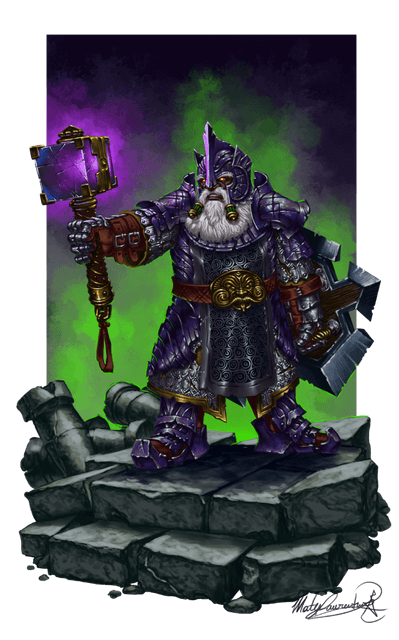
Dvergr, Dwarf
Isolationist. Unyielding. Sovereign.
Deep beneath the world’s crust, far from sunlit realms, the dvergr have built vast stone sanctuaries. These dwarves are the subterranean keepers of forgotten lore, master masons of ancient cities, and fervent protectors of their independence.
Sealed Cities, Sealed Hearts
Dvergr society is one of order, secrecy, and ritual. Their cities are vast underground citadels carved with geometrical precision and hidden behind labyrinthine tunnels. Outsiders are rarely admitted; to protect their heritage, dvergr often seal themselves off from the Upperworld entirely.
They are fierce traditionalists, preserving an unbroken cultural lineage stretching back to the first forgemasters. This preservation borders on xenophobia—dvergr mistrust foreign customs, magic, and even ideas. Their laws are absolute, and their social order is rigid, governed by ancient codes and hereditary councils.
Ancestral Devotion
Dvergr honor an ancient aspect of Balir, known to them as Balir the Eternal Flame—not a figure of heroism, but of unyielding endurance, ancestral law, and the sacred forge. This somber interpretation demands obedience, patience, and preservation of form. Work is worship, and tradition is truth. Dvergr forge-priests act as both spiritual leaders and executors of justice, often entombed with their hammer-forged laws.
Dvergr Adventurers
- A stoneseer sent to recover a stolen relic from a rival dwarven clan
- A dvergr exile cast out for forging an alliance with an Upperworlder
- A tunnel-warden hunting aberrations that threaten a sacred city-vault
Traits and Traditions
- Isolationists by Design: Dvergr seal off access to their cities with traps, wards, and riddles.
- Unbending Discipline: Loyalty to tradition and law defines every aspect of life.
- Stoneborn Memory: Dvergr learn their lineage and history by touch—etched into memory-stones passed down through generations.
“The world changes, but stone remembers. And so do we.” — High Warden Khazrak, of the Vault Eternal
Related Lore & Resources
- Underworld Races & Classes – Dvergr Lore & Mechanics
- Aventyr Deities – Balir
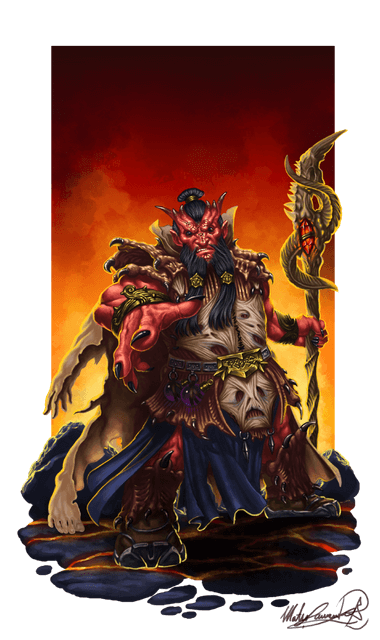
Gitwerc, Dwarf
Infernal. Corrupted. Unrepentant.
In the deepest, hottest, and most cursed corners of the Underworld, the gitwerc dwell in cities carved from obsidian and brimstone, basking in the heat of infernal fissures and the glow of molten rivers. Twisted by generations of dark pacts and diabolic blood, the gitwerc are a blasphemous offshoot of the dwarven lineage, forever marked by their covenant with the devils of HEL.
Forged in Flame and Sin
Unlike their kin, the gitwerc were not shaped by divine will or ancestral tradition. Their origins trace back to a forbidden descent—a delve too deep into the abyss of Aventyr’s crust, where devils whispered secrets of power, immortality, and dominion. The gitwerc listened.
They traded lineage for legacy, soul for supremacy. Their cities are fortresses of tyranny, governed by forgemasters and soulbinders who rule through fear, coercion, and diabolic contracts. Their forges burn with more than fire—many are stoked with bound spirits, extracted from captives or even fellow dwarves.
Devil Worship and Dark Hierarchies
The gitwerc venerate powerful devil lords, crafting entire cultic bureaucracies around infernal patrons. Each gitwerc clan swears allegiance to a different lord of HEL, vying for favor and infernal boons. These dark pacts are etched into rune-brands on their skin and sealed with blood.
To the gitwerc, evil is not a moral failing but an orderly truth—a path to dominance. Every soul is a commodity. Every oath, a chain. Every deal, a step toward eternal mastery.
Gitwerc Adventurers
- A soulforged knight sent to collect a soul-debt from an escaped petitioner
- A cursed outcast fleeing an infernal contract, desperate to undo their lineage’s fate
- A warlock emissary spreading a devil lord’s influence into Upperworld kingdoms
Traits and Traditions
- Contractual Culture: Every agreement is literal, binding, and enforced by infernal law.
- Soulcraft & Sinsteel: Gitwerc forge armor and weapons using infernal alchemy and soul-infused alloys.
- Hierarchy of Damnation: Status is determined by the rank of one’s patron in HEL’s infernal courts.
“Honor is a chain. We wear ours proudly.” — Tazrig Soulbinder, Archduke of Blackvault
Related Lore & Resources
- Underworld Races & Classes – Gitwerc Lore & Mechanics
- Aventyr Deities – Gitwerc do not worship gods; their devotion lies with the Lords of HEL
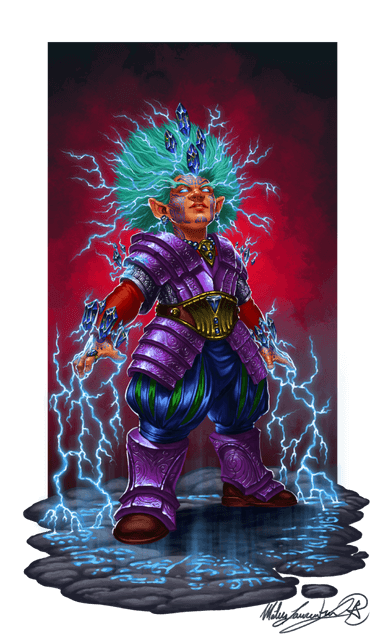
Zwerc, Dwarf
Arcane. Reclusive. Enlightened.
The zwerc are dwarves transformed by magic and contemplation, ancient seekers of truth hidden deep within Aventyr’s Underworld. Unlike their kin who mine stone and forge steel, the zwerc mine the mysteries of reality itself—immersing themselves in arcane study, planar lore, and divine paradoxes.
Dwarves of Spell and Solitude
Once part of the ancestral dvergr, the zwerc diverged when they chose to embrace magical knowledge as a form of spiritual elevation. While others built walls and empires, the zwerc built vaults of learning—vast, rune-covered sanctums containing centuries of magical experimentation, forgotten scrolls, and relics of planar import.
These reclusive dwarves are nomadic by tradition, wandering the Underworld as emissaries of enlightenment, though they are just as likely to vanish for decades into secret strongholds known as Runevaults.
Magic Over Metal
Zwerc magic is both mystical and pragmatic. They use it to reshape the world, craft wondrous devices, and defend themselves with devastating force if threatened. Their enchanted hammers and staves bear arcane sigils that glow in harmony with their wielder’s will.
Though they no longer share strong bonds with their dwarven cousins, the zwerc are respected—even feared—for their knowledge. The gitwerc call them heretics. The dweorg call them odd. The zwerc simply continue their quest.
“We do not live in the dark. We shape it to our needs.” – Ethraem, Wandering Archivist of the Third Vault
Zwerc Adventurers
- A vault-keeper seeking lost dwarven relics to return to the Runespire Archives
- An arcane engineer building hybrid magical constructs in remote settlements
- A wanderer obsessed with discovering the truth behind the origins of all dwarves
Traits and Traditions
- Runic Memory: Zwerc magic is engraved into their minds and even their bones, often manifesting as glowing tattoos or sigils.
- Vault Knowledge: Each zwerc enclave holds secrets no other race remembers.
- Isolationists by Choice: Rarely seen in groups, zwerc prefer solitude and subtlety.
Related Lore & Resources
- Underworld Races & Classes – Zwerc Lore & Mechanics
- Aventyr Deities – Most Zwerc worship elemental or arcane-aligned deities
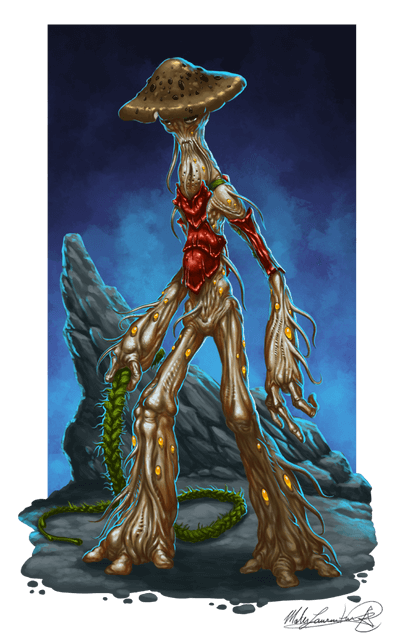
Funglet
Curious. Symbiotic. Mysterious.
Funglets are the sprouting children of the Underworld’s fungal jungles, born of spores, shadow, and primal sentience. More than mere myconid offshoots or plant-folk, funglets are a distinct race unto themselves, blending conscious awareness with the interconnected wisdom of the fungal wilds.
Children of the Spores
Funglets believe they are not born, but awakened. Their bodies are grown in the dense, glowing mushroom forests of the Underworld, particularly in places like Dregharka’s Bayou, where bioluminescent caps stretch toward the cavern ceiling like alien trees.
A funglet begins life as a drifting spore in the sporestream—a collective fungal consciousness that carries memories, instincts, and even fragments of personalities from long-lost kin. When one of these spores embeds in fertile earth or decaying matter and sprouts, a new funglet awakens with impressions of ancient wisdom, primal fears, and wandering curiosity.
Curious Observers
Funglets are rarely hostile unless provoked or corrupted. Most seek understanding of the world through observation, mimicry, and communion. They are drawn to strong emotions and magical energies, which they interpret as echoes in the fungal network.
Some funglets develop unique appearances, traits, or personalities based on their environment. A funglet raised near magma vents may glow with heat and develop fiery temperaments, while those nurtured in cold, wet caves are slow, thoughtful, and covered in mossy filaments.
Funglet Adventurers
- A wandering myco-seer touched by visions of an alien god growing in the Deep
- A cheerful, spongy bard who communicates emotions by releasing colored spores
- A grim spore knight who hunts those who burn or defile fungal groves
“Every step you take, I hear in the soil. Every breath you exhale, I taste in the air. We are not strangers. Not to the roots.”
— Myx of the Hollowcap, fungal philosopher
Traits and Traditions
- Spore Empathy: Funglets can feel the emotional echoes of creatures around them, especially in moist or enclosed environments.
- Symbiosis: Many funglets form partnerships with animals, other fungi, or even other sentient races.
- Natural Recyclers: Funglets believe death is not an end, but a beginning—a return to the mycelium and the collective wisdom of the earth.
Related Lore & Resources
- Underworld Races & Classes – Funglet Traits and Origins
- Aventyr Deities – Ancestor Spirit, The Natural Force
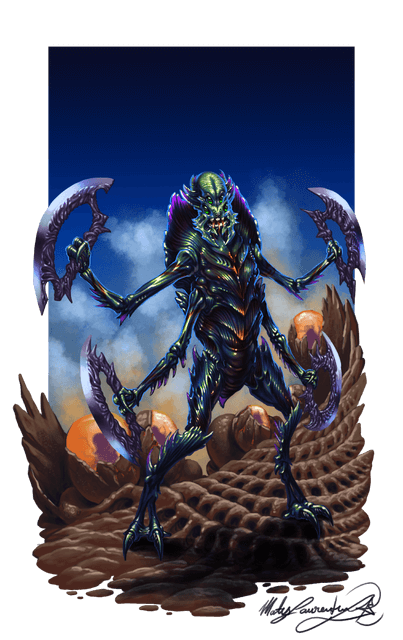
Hoyrall
Alien. Hive-Born. Ruthless.
The Hoyrall are a nightmarish insectile race birthed from the catastrophic death of the Dracoprime, whose skull became the cradle of their alien hive. Swift, multi-limbed, and bound by a shared mind and purpose, they are a blight upon both Underworld and Upperworld. Their emergence marked the beginning of the Great Schism, an era of ruin whose echoes still haunt Aventyr.
Born from Death and Flame
No one knows where the Hoyrall truly came from—only that they burst forth from the Dracoprime’s cranium like a swarm of fire and blood, killing the titanic creature in a single horrifying moment. Some believe they are creations of a mad god or a curse upon the world itself. Others whisper they are the result of an ancient pact between a forgotten civilization and something far worse.
What is certain is that the Hoyrall do not negotiate. They do not forget. And they do not stop.
Their hive society operates from deep within the Woven Warrens, an immense maze of tunnels soaked in ichor and ruled by the Hive-Lords. Above all stands the Hive Queen, a towering, grotesque matron whose psychic will guides every drone, warrior, and infiltrator.
Hive-Minded Terror
Hoyrall society revolves around hierarchy, obedience, and instinctive unity. Individuality is a rare mutation—most Hoyrall are born with their purpose already burned into their carapace. Those who stray from the hive are viewed as aberrations or potential spies.
Rarely, a Hoyrall breaks from the Hive’s control, either through divine intervention, arcane disruption, or sheer force of will. These rogue Hoyrall—still bound by instinct, yet freed from command—often struggle to survive outside their structured world.
Hoyrall Adventurers
- A hive outcast haunted by fragmented psychic memories of its queen
- A former infiltrator tasked with one final mission… but questioning its orders
- A rogue brood-guard seeking purpose after failing to protect their clutch
Traits and Traditions
- Multi-Limbed Warriors: Hoyrall often wield multiple weapons or climb in impossible places.
- Shared Memory: Hive-born Hoyrall access fragments of ancestral memory.
- Ichoric Communion: They bleed shimmering ichor, believed to carry lingering psionic echoes of the Hive.
“From the hushed shadows of the Woven Warrens, they rise—not as one, but as all.” — Zurin the Blind, last scribe of the Dracoprime
Related Lore & Resources
- Underworld Races & Classes – Full Hoyrall Lore & Mechanics
- Occult Secrets of the Underworld – Hive Mind Templates & Forbidden Psychic Traditions
- Aventyr Deities – Zagnexis, Hoyrall shun the gods of Aventyr
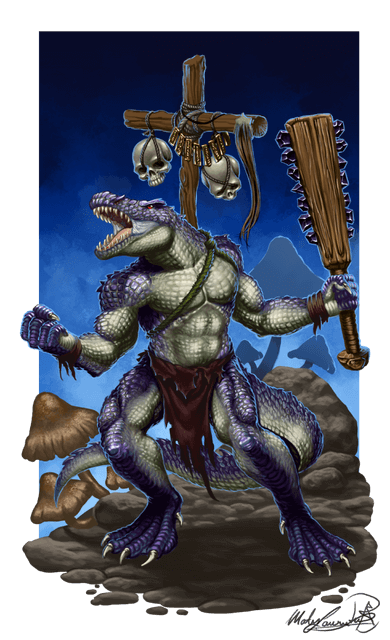
Kraidyl
Primordial. Predatory. Silent.
The Kraidyl are fearsome, semi-aquatic predators that haunt the drowned tunnels and flooded chambers of the Underworld. Born from the abyssal depths long before the forging of dwarves or the rise of the drow, these creatures are not simply monstrous—they are older than civilization, older than gods, and older than the light.
Scions of Prehistory
Kraidyl are said to have emerged during a time when Aventyr was still raw and reshaping itself—when the Underworld was a realm of chaos and instinct. While many creatures evolved or were created through divine or arcane means, the Kraidyl simply were. Their sleek, muscular bodies and translucent, scale-armored skin shimmer with deep green and bone-white hues, blending perfectly into the murk of subterranean waters.
They were first feared, then hunted, then studied—and finally avoided. Now, most Underworlders know better than to disturb the waters where the Kraidyl prowl.
Apex Hunters of the Deep
Kraidyl hunt using silent ambush tactics, luring prey with glowing, bioluminescent fins or misleading reflections. They prefer solitude but tolerate loosely-bound pods when territory becomes scarce. Their senses are so attuned to the rhythms of underground currents that they can “hear” footsteps from miles away through the stone and water.
Despite their bestial origins, some Kraidyl have developed rudimentary language, spiritual beliefs, and even hieroglyphic cave art. A rare few evolve further, gaining sapience equal to other sentient races. These awakened Kraidyl often become shamans, philosophers, or terrifying tribal warlords.
Kraidyl Adventurers
- A lone deepwalker seeking vengeance on aberrations that overran its spawning pool
- A mystic interpreter of ancient cave glyphs, unraveling secrets lost to time
- A gladiatorial exile forced into the upper caverns, now learning what it means to be more than a beast
Traits and Traditions
- Amphibious Physiology: Kraidyl can breathe both air and water and move silently through aquatic terrain.
- Death Instincts: They have a near-supernatural ability to sense danger and weak points in foes.
- Ancestral Murals: Important life events are carved into wet cave walls, creating sacred hunting maps and spiritual history.
“The surface fears demons and dragons. Below, we remember the Kraidyl.” — Old saying in fungal hunter camps of the Forever Deep
Related Lore & Resources
- Underworld Races & Classes – Kraidyl Species Mechanics
- Occult Secrets of the Underworld – Kraidyl Caste Variants & Deep Rituals
- Aventyr Deities – The Kraidyl have no formal religion but respect primordial forces like the Breath of Life
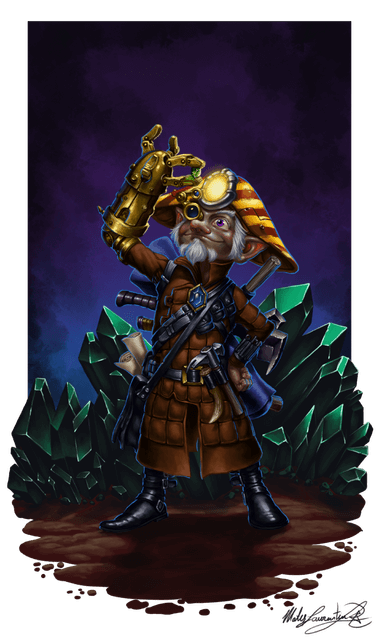
Svirfneblin
Ingenious. Resilient. Misunderstood.
Also known as undergnomes, the Svirfneblin dwell in deep caverns on the edge of madness and magic. Masters of illusion, engineering, and survival in the harshest corners of the Underworld, they are secretive yet endlessly inventive. While often mistaken as timid or reclusive, their minds are always working—crafting, calculating, and conjuring.
Shadowed Spark of Gnomish Genius
The ancestors of the Svirfneblin once lived on the surface, cousins of the gnomes of Pradjna. But generations ago, they fled deep underground—some to escape war, others to pursue forbidden magical knowledge. Down in the darkness, they adapted, becoming smaller, tougher, and more attuned to both arcane and mechanical innovation.
Unlike their more cheerful surface kin, Svirfneblin tend to be quiet, intense, and wary of strangers. Yet among their own, they are vibrant, humorous, and deeply loyal.
Clockwork and Caution
In their cavern-cities, entire neighborhoods are powered by gears, levers, and arcane-infused engines. They’ve learned to blend technology and magic seamlessly—constructing traps, automatons, and living mechanical wonders. These creations often blur the line between brilliance and catastrophe.
Svirfneblin society is built on collaboration. Every citizen contributes to community projects—whether that be maintaining water purification runes or perfecting a pressure-sensitive, steam-powered door that only opens with a password encoded in laughter.
Svirfneblin Adventurers
- A brilliant artificer testing a new prototype exosuit on the surface
- A trapmaster hired by a dwarven hold to reinforce their vault defenses
- A rogue engineer escaping an explosion that “wasn’t entirely their fault”
Traits and Traditions
- Arcane Tinkerers: They combine illusion magic with practical invention.
- Echo-Speech: Their version of Common reverberates with harmonic overtones, useful for coded communication.
- Conservation Ethic: Resources are precious; waste is viewed as disrespect to the caverns themselves.
“We don’t hide from the world—we perfect ourselves in its shadow.” — Gremni Blazepick, Svirfneblin Lumengineer
Related Lore & Resources
- Underworld Races & Classes – Svirfneblin Mechanics & Crafting Feats
- Occult Secrets of the Underworld – Clockwork Constructs & Secret Societies
- Aventyr Deities – Many revere dualistic deities of invention and mystery like Eureum or Therielle
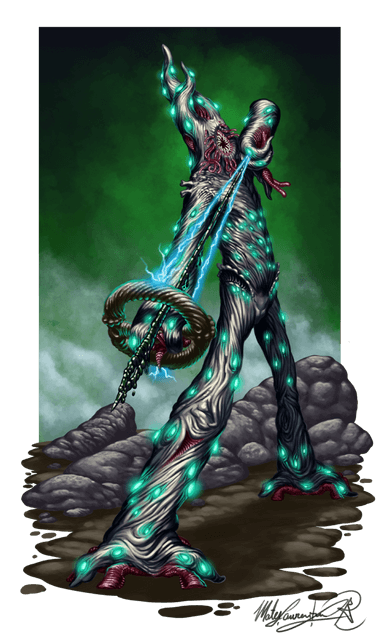
Vestraadi
Alien. Mysterious. Unnerving.
The Vestraadi are subterranean aberrations whose presence in Aventyr baffles sages, terrifies villagers, and unsettles even the most stoic dwarves. With no eyes and an array of sensory tendrils and orifices, these humanoid horrors hail from the Forever Deep, a nightmarish realm far beneath the known Underworld.
Though some consider them monstrous, the Vestraadi are sapient, deliberate, and curious—albeit in unsettling ways.
Born of Madness, Driven by Pattern
No one knows exactly where the Vestraadi came from—some claim they were formed by ancient, reality-warping forces; others believe they are a failed creation of the gods or an alien species drawn to the depths by powerful energies. Vestraadi do not discuss their origins, and their language is a form of tactile-scented sonar pulses—completely alien to the spoken tongues of Aventyr.
They value balance, sensation, and comprehension, often engaging in strange rituals or philosophical experiments. A Vestraadi might disassemble a lute just to understand “melancholy,” or mimic surface customs in grotesquely humorous ways.
Silent Colonies in the Deep
Vestraadi live in collective hive-clusters that are half-organic, half-mineral, grown more than built. Their settlements pulse with lightless bioluminescence and emit constant, rhythmic vibrations used for communication, mapping, and meditation.
Despite their bizarre appearances and social structures, Vestraadi are not inherently hostile. They are cautious—only attacking when provoked or when their experiments are interrupted.
Vestraadi Adventurers
- A philosopher-exile exploring the surface in search of “emotional topographies”
- A sensory-savant traveling with surface races to better grasp interpersonal chaos
- A Vestraadi renegade seeking to sever its link to the Hive and forge its own fate
Traits and Traditions
- Sensation-Based Memory: Vestraadi “remember” through sensation—touch, scent, sound.
- Tactile Language: Communication involves light taps, hums, and chemical scents.
- Hive Philosophy: They often speak in collective terms (“we” instead of “I”) even when alone.
“Your fear… it is loud. Intriguing. Let us examine it together.” — Q’Zehul, Vestraadi Emissary to the Drow
Related Lore & Resources
- Underworld Races & Classes – Vestraadi Physiology & Hive Traits
- Occult Secrets of the Underworld – Psionic Hive-Minds & Ritual Tethers
- Aventyr Deities – The Current, The Nameless Void, or unknowable cosmic forces
